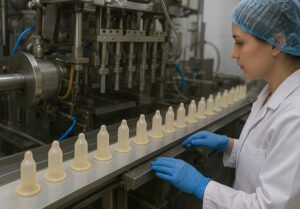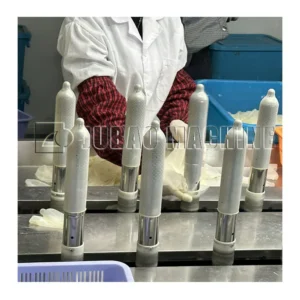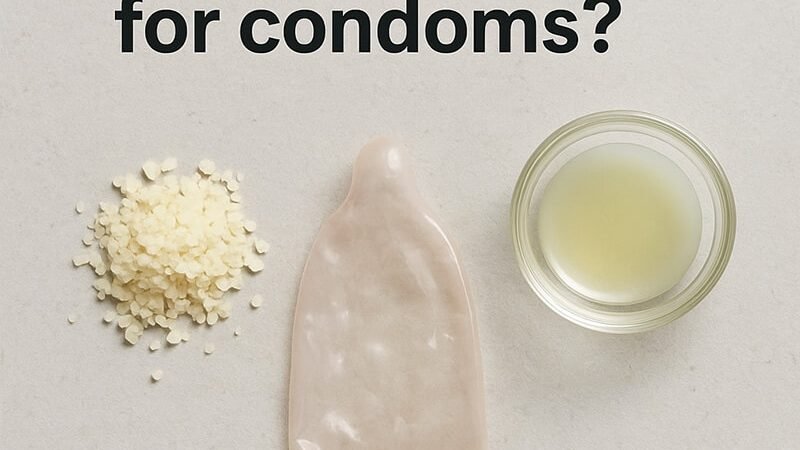What are the Raw Materials for Condoms? A Comprehensive Guide to Condom Manufacturing Materials
Table of Contents
1. Introduction
Condoms are one of the most important barrier contraceptive methods available today, serving dual purposes as both pregnancy prevention and sexually transmitted infection (STI) protection. Understanding the raw materials used in condom manufacturing is crucial for consumers, healthcare professionals, and manufacturers alike. This comprehensive guide explores the various materials used in condom production, from traditional natural latex to modern synthetic alternatives.
The choice of raw materials directly impacts the condom’s effectiveness, durability, comfort, and compatibility with different users. With advances in material science and manufacturing technology, today’s condoms offer a wide range of options to meet diverse needs and preferences.
2. Natural Latex Rubber
Natural latex rubber remains the most widely used material for condom manufacturing, accounting for approximately 85-90% of all condoms produced globally. This material is derived from the rubber tree Hevea brasiliensis and has been the foundation of condom manufacturing for over a century.
2.1 Latex Harvesting and Processing
Natural latex is harvested through a process called tapping, where skilled workers make diagonal cuts in the bark of rubber trees to collect the milky white sap. This raw latex contains approximately 30-35% rubber particles suspended in water, along with proteins, sugars, and other organic compounds.
The processing of natural latex for condom manufacturing involves several critical steps:
- Concentration: The latex is concentrated to increase the rubber content to approximately 60%
- Preservation: Ammonia is added to prevent bacterial degradation during storage and transport
- Compounding: Various chemicals are added to enhance properties such as strength, elasticity, and aging resistance
- Filtration: The latex is filtered to remove impurities and foreign particles
2.2 Advantages and Limitations
Natural latex offers several advantages that make it ideal for condom manufacturing. It provides excellent elasticity, allowing condoms to stretch significantly without breaking. The material also offers superior barrier properties against viruses and bacteria, making it highly effective for disease prevention.
Important Note: While natural latex is highly effective, it can cause allergic reactions in some individuals. Latex allergies affect approximately 1-6% of the general population and can range from mild skin irritation to severe anaphylactic reactions.

3. Synthetic Materials
The development of synthetic materials has revolutionized condom manufacturing, offering alternatives for individuals with latex allergies and providing unique properties that enhance user experience. These materials are produced through chemical synthesis rather than natural extraction.
3.1 Polyurethane
Polyurethane condoms represent a significant advancement in synthetic condom technology. This material is created through the reaction of polyols with diisocyanates, resulting in a polymer with exceptional properties for barrier contraception.
Key characteristics of polyurethane include:
- Superior heat conductivity, providing a more natural feeling during use
- Compatibility with all types of lubricants, including oil-based products
- Thinner construction while maintaining strength and barrier effectiveness
- Hypoallergenic properties, suitable for latex-sensitive individuals
- Resistance to degradation from exposure to light, heat, and ozone
3.2 Polyisoprene
Synthetic polyisoprene is chemically similar to natural latex but produced without the proteins that cause allergic reactions. This material combines the familiar feel of latex with the safety profile needed for sensitive users.
The manufacturing process involves polymerizing isoprene monomers using specialized catalysts to create long polymer chains. The resulting material offers excellent elasticity and strength while eliminating the allergens found in natural latex.
3.3 Nitrile
Nitrile rubber, also known as acrylonitrile butadiene rubber (NBR), is primarily used in specialized condom applications. While less common than other materials, nitrile offers unique properties including exceptional chemical resistance and durability.
4. Additives and Processing Chemicals
The raw base materials alone are insufficient for producing high-quality condoms. Various additives and processing chemicals are essential to achieve the desired properties and ensure product safety and effectiveness.
4.1 Vulcanization Agents
Vulcanization is a critical process that cross-links polymer chains to create the elastic properties essential for condom function. The primary vulcanization system includes:
- Sulfur: The primary cross-linking agent that forms sulfur bridges between polymer chains
- Accelerators: Chemicals like zinc mercaptobenzothiazole that speed up the vulcanization process
- Activators: Zinc oxide and stearic acid that enhance accelerator effectiveness
- Retarders: Chemicals that control the vulcanization rate to prevent premature curing
4.2 Stabilizers and Antioxidants
To ensure long-term stability and prevent degradation, various stabilizers are added to the rubber compound:
- Antioxidants: Prevent oxidation that can cause rubber degradation and brittleness
- Anti-ozonants: Protect against ozone-induced cracking and deterioration
- UV stabilizers: Prevent degradation from ultraviolet light exposure
- Heat stabilizers: Maintain properties during manufacturing heat exposure
4.3 Lubricants and Coatings
Lubricants play a crucial role in condom comfort and effectiveness. Common lubricant materials include:
- Silicone-based lubricants: Provide long-lasting lubrication and are compatible with all condom materials
- Water-based lubricants: Safe with latex condoms but may require reapplication
- Hybrid lubricants: Combine water and silicone for optimal performance
5. Specialty Materials
Modern condom manufacturing incorporates various specialty materials to enhance user experience and meet specific market demands.
5.1 Textured Condom Materials
Textured condoms utilize additional materials and manufacturing techniques to create surface variations. These include:
- Raised dots or studs created through specialized molding processes
- Ribbed patterns formed during the dipping process
- Combination textures using multiple manufacturing techniques
5.2 Flavored and Colored Materials
Specialty condoms may incorporate food-grade flavorings and colorants to enhance appeal and user experience. These additives must meet strict safety standards and undergo extensive testing to ensure they don’t compromise barrier effectiveness.

6. Quality Control Materials
Quality control in condom manufacturing requires various testing materials and equipment to ensure product safety and effectiveness. This includes materials for electronic testing, water leak testing, and tensile strength evaluation.
Standard quality control procedures involve testing every single condom for holes and defects using electronic testing equipment. Additionally, statistical sampling tests evaluate burst strength, elongation properties, and aging characteristics using specialized testing materials and procedures.
7. Environmental Considerations
The environmental impact of condom raw materials is an increasingly important consideration in manufacturing. Natural latex is biodegradable, typically breaking down within 2-5 years under appropriate conditions. However, synthetic materials like polyurethane may persist longer in the environment.
Manufacturers are exploring more sustainable options, including:
- Sustainable latex harvesting practices that don’t harm rubber trees
- Biodegradable synthetic alternatives
- Reduced packaging materials and eco-friendly packaging options
- Energy-efficient manufacturing processes
8. Conclusion
The raw materials used in condom manufacturing have evolved significantly over the decades, from simple natural latex to sophisticated synthetic polymers and specialty additives. Understanding these materials helps consumers make informed choices based on their individual needs, sensitivities, and preferences.
Natural latex remains the gold standard for most applications due to its excellent barrier properties and elasticity. However, synthetic alternatives like polyurethane and polyisoprene offer valuable options for those with allergies or specific performance requirements.
As technology continues to advance, we can expect further innovations in condom materials, with a focus on enhanced comfort, improved barrier effectiveness, and environmental sustainability. The future of condom manufacturing will likely see even more sophisticated materials that balance safety, performance, and environmental responsibility.
Final Note: When choosing condoms, it’s essential to select products from reputable manufacturers that meet international safety standards. All condoms should be FDA-approved or meet equivalent international regulatory requirements to ensure maximum protection and safety.
